Plan for Bare Metal Solution
This document explains the key components of Bare Metal Solution to help you decide how to deploy servers, networking, and storage in your own Bare Metal Solution environment.
If you are running SAP HANA in your Bare Metal Solution environment, then see the SAP HANA on Bare Metal Solution planning guide.
Regional availability
Bare Metal Solution is available in the following Google Cloud regions:
| Region | Location |
|---|---|
asia-northeast1 |
Tokyo, Japan, APAC |
asia-northeast3 |
Seoul, South Korea, APAC |
asia-southeast1 |
Jurong West, Singapore, APAC |
europe-west2 |
London, England, Europe |
europe-west3 |
Frankfurt, Germany, Europe |
europe-west4 |
Eemshaven, Netherlands, Europe |
northamerica-northeast1 |
Montréal, Québec, Canada, North America |
northamerica-northeast2 |
Toronto, Ontario, Canada, North America |
southamerica-east1 |
Osasco, São Paulo, Brazil, South America |
us-central1 |
Council Bluffs, Iowa, USA, North America |
us-east4 |
Ashburn, Virginia, USA, North America |
us-west2 |
Los Angeles, California, USA, North America |
The following table shows the Google Cloud regions that support SAP HANA on Bare Metal Solution servers.
| Region | Location |
|---|---|
europe-west3 |
Frankfurt, Germany, Europe |
europe-west4 |
Eemshaven, Netherlands, Europe |
us-central1 |
Council Bluffs, Iowa, USA, North America |
us-east4 |
Ashburn, Virginia, USA, North America |
If you don't see the region that you need in the preceding table, then contact Google Cloud Sales.
Server configurations
Bare Metal Solution offers servers in pre-configured sizes, as shown in the following table.
Each Bare Metal Solution server comes with 200 GB of network attached storage for the boot disk.
By default, CPU hyper-threading is disabled in Bare Metal Solution servers. If you need hyper-threading, let your sales representative know or, if you already have Bare Metal Solution, open a service request.
| Server name | CPU cores | vCPUs | Sockets | Memory | CPU platform | Ethernet ports |
|---|---|---|---|---|---|---|
| General-purpose servers | ||||||
o2-standard-16-metal |
8 | 16 | 2 | 192 GB | Intel Xeon Gold, 5200 series, 3.8 GHz | 4 port 25GbE NIC |
o2-standard-32-metal |
16 | 32 | 2 | 384 GB | Intel Xeon Gold, 6200 series, 3.2 GHz | 4 port 25GbE NIC |
o2-standard-48-metal |
24 | 48 | 2 | 768 GB | Intel Xeon Gold, 6200 series, 3.0 GHz | 4 port 25GbE NIC |
o2-standard-112-metal |
56 | 112 | 2 | 1.5 TB | Intel Xeon Platinum, 8200 series, 2.2 GHz | 4 port 25GbE NIC |
| High-memory general-purpose servers | ||||||
o2-highmem-224-metal |
112 | 224 | 4 | 3 TB | Intel Xeon Platinum, 8200 series, 2.7 GHz | 4 port 25GbE NIC |
| Memory-optimized servers | ||||||
o2-ultramem-672-metal |
336 | 672 | 12 | 18 TB | Intel Xeon Platinum, 8200 series, 2.7 GHz | 6 port 25GbE NIC |
o2-ultramem-896-metal |
448 | 896 | 16 | 24 TB | Intel Xeon Platinum, 8200 series, 2.7 GHz | 8 port 25GbE NIC |
Firmware
We recommend that you install the latest version of Bare Metal Solution
firmware on your servers: TS54.
Using an outdated firmware version can cause issues including the following:
- Delayed and limited Google Cloud support.
- Loss of critical Google Cloud features.
- Security, compliance, and performance issues.
To learn how to upgrade firmware, see Upgrade firmware.
Identify your firmware version
To identify the current firmware version of your Bare Metal Solution server, run the following command:
sudo dmidecode -s bios-version
Available firmware versions
The following table provides details for the firmware versions available for Bare Metal Solution.
General information
| Firmware version | Machine series | Machine type | Lifecycle stage | EOL and firmware deprecation date |
|---|---|---|---|---|
| BIOS_PUR043.45.00.002 (TS54) |
|
General-purpose | GA | To be determined |
| BIOS_PUR043.37.14.021 (TS24.02) |
|
General-purpose | End of Life | April 2024 |
| BIOS_PUR043.37.16.023 (TS24.05) |
|
General-purpose | End of Life | April 2024 |
| 3.50.58 |
|
Memory-optimized servers | GA | March 2024 |
| 3.80.24 |
|
Memory-optimized servers | GA | To be determined |
Features
| Firmware version | Features |
|---|---|
| BIOS_PUR043.45.00.002 (TS54) |
|
Upgrade firmware
To upgrade your server to the latest firmware version, contact Customer Care.
We need a 5-day notice to schedule the upgrade. The upgrade requires approximately 10 hours to complete. We can upgrade three servers concurrently in a 10 hour window.
Interactive serial console
Bare Metal Solution provides an interactive serial console to access your servers. You can use it to perform configuration and troubleshooting tasks. You can directly run commands and respond to prompts in the serial console.
To learn how to configure and use the serial console, see Configure the serial console.
Operating systems
When you place an order for Bare Metal Solution, you can specify the operating system (OS) that you need installed on your servers. If you need an OS that does not appear in the following tables, contact Google Cloud Sales.
Available OS images
You can request the installation of the following OS images on your Bare Metal Solution servers. This section provides general details for the OS images.
| OS version | OS image code | Machine series | Machine type | Lifecycle stage | EOL and image deprecation date |
|---|---|---|---|---|---|
| RHEL 7.7 for SAP | LAMBRHEL77SAP |
|
Memory-optimized servers (appropriate for SAP HANA) | End of Life | August 2023 |
| RHEL 7.9 | RHEL7x |
|
General-purpose | GA | June 2024 |
| RHEL 8.4 (Minor version locked) | RHEL84 |
|
General-purpose | End of Life | May 2023 |
| RHEL 8 (Latest minor release) | RHEL8x |
|
General-purpose | GA | May 2029 |
| RHEL 8.0 for SAP | RHEL80SAP |
|
General-purpose | End of Life | December 2020 |
| RHEL 8.1 for SAP | RHEL81SAP |
|
General-purpose | End of Life | November 2023 |
| RHEL 9.4 (Minor version locked) | RHEL94 |
|
General-purpose | End of Life | May 2023 |
| RHEL 9 (Latest minor release) | RHEL9x |
|
General-purpose | GA | May 2032 |
| OEL 7.9 | OEL7x |
|
General-purpose | GA | July 2024 |
| OEL 8 (Latest minor release) | OEL8x |
|
General-purpose | GA | July 2029 |
| OEL 8.8 (Minor version locked) | OEL88 |
|
General-purpose | GA | June 2025 |
| OEL 9 | OEL9x |
|
General-purpose | GA | June 2032 |
| SLES 15 SP1 | SLES15SPx |
|
General-purpose | End of Life | January 2024 |
| SLES 12 SP4 for SAP | SLES12SP4SAP |
|
General-purpose & Memory-optimized servers (appropriate for SAP HANA) | End of Life | June 2023 |
| SLES 12 SP5 for SAP | SLES12SP5SAP |
|
General-purpose & Memory-optimized servers (appropriate for SAP HANA) | GA | October 2027 |
| SLES 15 for SAP | SLES15SAP |
|
General-purpose | End of Life | December 2022 |
| SLES 15 SP1 for SAP | SLES15SPxSAP |
|
General-purpose & Memory-optimized servers (appropriate for SAP HANA) | End of Support | January 2024 |
| SLES 15 SP2 for SAP | LAMBSLES15SP2SAP |
|
Memory-optimized servers (appropriate for SAP HANA) | GA | December 2024 |
Bring Your Own Image (BYOI)
The Bare Metal Solution servers are certified to run only the OS images of the following distributions:
- Red Hat Enterprise Linux (RHEL)
- Oracle Linux (OL)
- SUSE Linux Enterprise Server (SLES)
Any other OS hasn't been tested or certified to run on the Bare Metal Solution servers.
If the OS image you want use is not listed in the available OS images list, you can use your own image. However, you must keep the following things in mind:
Our technical support primarily focuses on infrastructure-related issues. We don't provide support for issues related to OS, drivers, and compatibility. For the best assistance with these issues, we recommend contacting your OS vendor directly. They have the most in-depth knowledge to help you troubleshoot.
Your OS image must comply with all the OS image technical specifications.
Installing BYOI OS image
To install your BYOI OS image on Bare Metal Solution, do the following:
- Ensure that your OS image meets all the OS image technical specifications.
- Remove any personally identifiable information (PII) from the OS image.
- Open a Google Cloud support case requesting the use of your OS image. In the support case, provide a secure download link to your OS image.
Once we receive your request, we evaluate your OS image and provide technical guidance regarding its installation on the Bare Metal Solution. It is your responsibility to adhere to the guidance and install the OS image on your server.
OS image technical specifications
The OS image you want to use must comply with the following guidelines:
- The OS image must support UEFI boot type.
- The OS image must contain EFI partition and GPT partition type.
- The OS image must have a size equal to or smaller than 200 GiB.
- The disk format for the OS image must be
raw. - The OS image must have the multipath package installed and the multipath daemon enabled during boot.
- The
initramfsmust contain the multipath module. - The Linux LVM must be configured to scan only the multipath device nodes, and
specifically not scan the raw device nodes which represent individual paths to
the SAN (
/dev/sd*). It is the LVM filter, found in/etc/lvm/lvm.conf, that determines the devices to be scanned. - The
fstabentries must use UUIDs or file system labels to mount the file system and not device files as they may contain the SAN Disk WWID or the device names change when deployed in a multipath environment. - The GRUB must be configured to send the console output to the serial port
ttyS0 at a baud rate of
115200as well as sending the output to the regular console or "screen" tty0.
Hypervisors
When you place an order for Bare Metal Solution, you can request that a hypervisor be installed on your servers. If you request a hypervisor, you must install any guest operating system yourself.
You can request the following hypervisor:
- Oracle VM
- 3.4.6
To use Oracle Linux Virtualization Manager (OLVM - a KVM-based hypervisor), request a compatible Linux OS such as Oracle Linux 7.
Storage
For storage in a Bare Metal Solution environment, you need to select the type of storage you need, know how to maximize the performance, and decide if you want to enable snapshots.
Storage choices
Storage devices in the regional extension provide local storage to Bare Metal Solution servers. There are three types of local storage you can request:
- Fibre Channel-based block storage presented as logical unit numbers (LUNs) and accessible by only one Bare Metal Solution server.
- Fibre Channel-based block storage presented as multipath LUNs and shared with multiple Bare Metal Solution servers. This option is good for high-availability applications, such as Oracle Database RAC.
- Network File System (NFS) storage. With NFS, you mount a shared storage directory on one or more Bare Metal Solution servers and access the directory like any other file system. For information on how to implement NFS, see Add NFS file storage to a Bare Metal Solution environment.
For Fibre Channel-based block storage, you can choose the following storage options in 1 TiB increments up to a maximum of 16 TiB for regular SSD and HDD and to a maximum of 8 TiB for Performance SSD. For NFS, you can choose the following storage options with a minimum of 100 GiB and a maximum of 16 TiB.
| Storage type | Snapshot support | Common Workloads |
|---|---|---|
| SSD (solid-state drive) | Yes | Mission-critical production workloads |
| HDD (hard drive) | Yes | Local backups or archival workloads |
Here are some additional storage volume considerations that you need to understand:
- We don't recommended using hard disk drives (HDDs) to run mission-critical Oracle production workloads, because performance guidance is not available for HDD storage.
- When you provision any Fibre Channel or NFS storage volume, the volume size becomes fixed and you can't expand the volume. Also, the type and the performance tier of the of the storage volume remains fixed and can't be changed without ordering new storage and performing host-based data migration.
- If you need additional storage space, you need to purchase additional storage volumes.
- You cannot expand the existing LUNs in a storage volume. Instead, you need to order new LUNs and a new storage volume, migrate the old LUNs to the new storage volume, and decommission the old LUNs.
- When you migrate the LUNs to a new storage volume, you also need to migrate the data.
If you run Oracle Automatic Storage Management (ASM), the following options are available:
When you need to expand an ASM disk group, you can order another storage volume, rescan the SCSI hosts to discover the new LUNs, and use ASM to add the new storage capacity into the disk group.
You can use the following command to perform an SCSI rescan on Red Hat Linux or Oracle Linux:
sudo rescan-scsi-bus.sh -aWhen you add, drop, or resize disks, ASM automatically initiates a rebalance to prevent an unnecessary load on the production database.
When you remove a storage volume from service in a Bare Metal Solution environment, the Bare Metal Solution server reboots. The length of the outage can last from 20 minutes to an hour, depending on the size of your Bare Metal Solution server and the amount of storage attached to the server.
You can attach a maximum of 200 LUNs (including the boot LUN) to a Bare Metal Solution server.
Storage performance
Standard SSD Storage
For Fibre Channel and NFS storage, Bare Metal Solution provides throughput and input/output operations per second (IOPS) performance calculated according to the following formula for an 8 KiB block size on an SSD drive:
Calculated IOPS = 7200 * Volume Size in TiB Maximum Throughput (MiBps) = Calculated IOPS * 8 / 1024
The following table shows the IOPS and the throughput for common volume sizes:
| Volume size | Read/Write IOPS | Throughput (MiBps) | Read/Write latency |
|---|---|---|---|
| 200 GiB (0.2 TiB) | 1400 | 10.9 | < 1 ms |
| 1 TiB | 7200 | 56 | < 1 ms |
| 4 TiB | 28800 | 225 | < 1 ms |
| 8 TiB | 57600 | 450 | < 1 ms |
| 12 TiB | 86400 | 675 | < 1 ms |
| 16 TiB | 115200 | 900 | < 1 ms |
Performance SSD Storage
For Fibre Channel storage, Bare Metal Solution provides throughput and input/output operations per second (IOPS) performance calculated according to the following formula for a 32 KiB block size on a Performance SSD drive:
Calculated IOPS = 8192 * Volume Size in TiB Maximum Throughput (MiBps) = Calculated IOPS * 32 / 1024
The maximum volume size for a Performance SSD volume is 8 TiB.
The following table shows the IOPS and the throughput for common volume sizes:
| Volume size | Read/Write IOPS | Throughput (MiBps) | Read/Write latency |
|---|---|---|---|
| 1 TiB | 8192 | 256 | < 1 ms |
| 2 TiB | 16384 | 512 | < 1 ms |
| 4 TiB | 32768 | 1024 | < 1 ms |
| 8 TiB | 65536 | 2048 | < 1 ms |
Use the following storage recommendations to improve the performance of your databases and applications in your Bare Metal Solution environment:
- When you deploy multiple storage volumes, use consistent volume sizes to get consistent performance for databases and applications.
- When you add a new storage volume, always remember to rescan the LUNs to detect the new storage capacity.
Storage volume snapshots
The Bare Metal Solution provides options to save snapshots of your storage volumes to use for recovery purposes. Snapshots are available as follows:
- OS boot volume: Google Cloud takes a daily snapshot by default.
- Data volume: You can request daily snapshots when you place your initial order for Bare Metal Solution. You can also contact Customer Care to request data volume snapshots for existing storage volumes.
Google Cloud takes snapshots of the boot OS volume automatically every day at 12:10 AM in the region where your Bare Metal Solution servers are located. We also take a snapshot of your data volume if you have ordered this. We retain the snapshots for 7 days, and you cannot modify the schedule for these snapshots.
The following diagram shows the default process of how snapshots fill up a storage volume.
- When Google Cloud enables snapshots on a data volume, we reserve 80% of the volume for regular data and 20% of the volume for snapshots. The latter is called the snapshot reserve.
- When the snapshot reserve fills its original 20% space, the volume grows automatically by an additional 20%. This increases both the data area and the snapshot reserve proportionally.
- If the snapshot reserve becomes 100% full, snapshots spill over into the data area.
- If both the data area and snapshot reserve become 100% full, the volume goes offline to prevent corruption of the LUNs. Write operations are suspended.
- To bring the volume back online, you need to reclaim sufficient space in the volume by deleting prior snapshots.
Your data volume might fill up as the result of a high rate of data change within the LUN(s). For example, an application might write and delete large amounts of data within a 24-hour period.
To delete data volume snapshots and bring a data volume back online, or restore an OS boot volume snapshot, contact Customer Care.
Networking
Each Bare Metal Solution environment resides in a secure region extension that is connected to the corresponding Google Cloud region by a Partner Interconnect connection that is provided and managed by Google Cloud.
VLAN attachment pairs are used to connect your Bare Metal Solution environment to Google Cloud project and to on-premises network.
Choose standard networking or explore advanced networking options
The standard networking configuration for Bare Metal Solution offers a basic network topology that is appropriate for most small-scale deployments. The standard networking configuration includes:
Four physical interfaces for each Bare Metal Solution server. We bundle the interfaces into two logical interfaces called bonds. These bonded interfaces use a standard networking template to provide basic redundancy and load balancing.
- There are two
25 Gbpsphysical interfaces per bond interface. - The first bond interface
bond0connects a single client network to the Google Cloud. - The second bond interface
bond1connects a single private network to services and applications running locally in your Bare Metal Solution environment. By default,
bond0is mapped to a client network andbond1to a private network created through the Google Cloud console intake form. However, in a multi-network configuration you can create client and private networks in any combinations.A single Partner Interconnect VLAN attachment pair connects your Virtual Private Cloud to the client network in your Bare Metal Solution environment
- There are two
You create a Cloud Router before provisioning VLAN attachment pair.
- Cloud Router is a distributed, highly available, software defined router in Google Cloud.
- You can create and use a single Cloud Router for both VLAN attachments in the pair or separate Cloud Router for each VLAN attachment in the pair depending on your design. The diagrams in this document uses a single Cloud Router option.
In the following diagram, VRF is an interface connecting a client network to a VLAN attachment pair. Learn more about VRF in Bare Metal Solution.
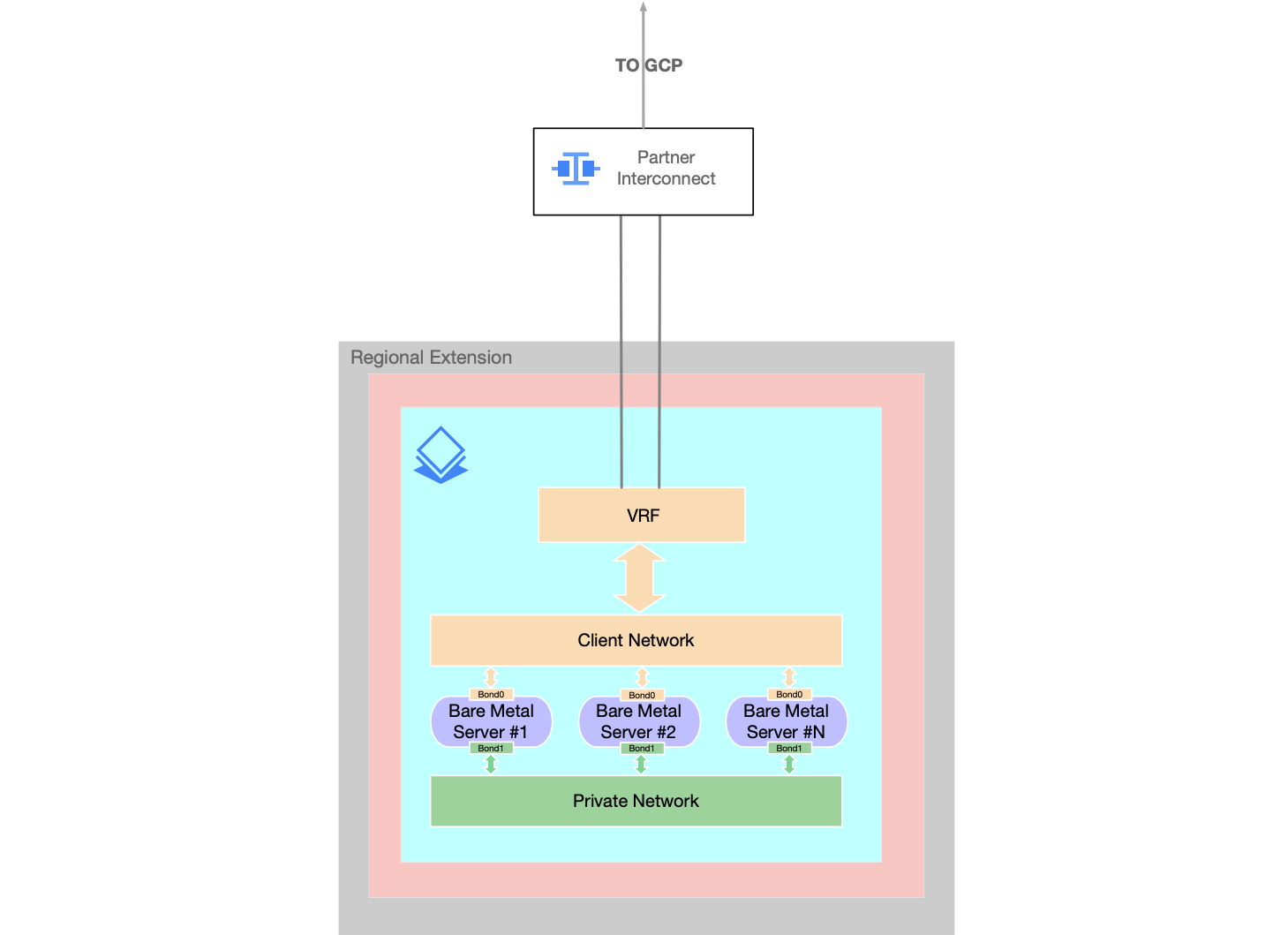
We recommend using the following Bare Metal Solution standard networking configuration for small scale deployments:
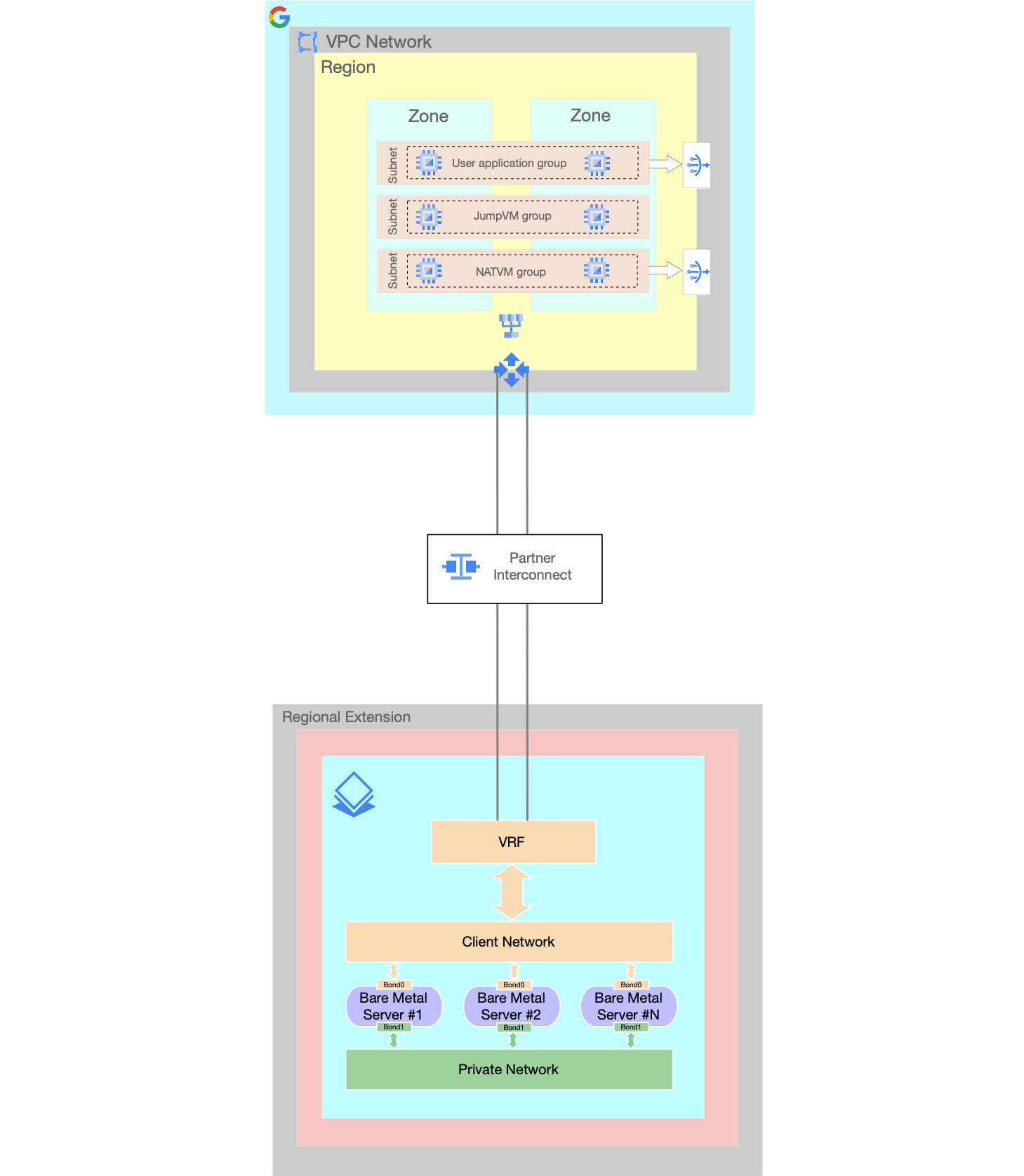
The standard networking configuration consist of the following:
- A single client network connects Bare Metal Solution servers to the Google Cloud using a single Partner Interconnect VLAN attachment pair.
- A single private network connects Bare Metal Solution servers to the local environment with other Bare Metal Solution servers.
If the standard networking configuration does not meet your needs, you can consider implementing some advanced networking capabilities. If you already have a Bare Metal Solution environment and would like to migrate to an advanced networking configuration, contact Customer Care. If you are a new customer and would like to implement an advanced networking configuration, contact Google Cloud Sales.
When your order an advanced networking configuration, the following options become available for more complex network deployments:
- Multiple VLANs
- Multiple VLAN attachments
- Multiple VPC connections
- Maximum transmission unit
- Network templates
Multiple VLANs
Instead of a single client network and single private network for each bonded interface, you can add multiple client networks and private networks on server bond interfaces.
- The additional networks can be the client or private, or a combination of both.
- You can add both client networks and private networks on
bond1or onbond0interface.
- You can add both client networks and private networks on
- You can add up to 10 Networks per bonded interface and a total of 20 networks per server.
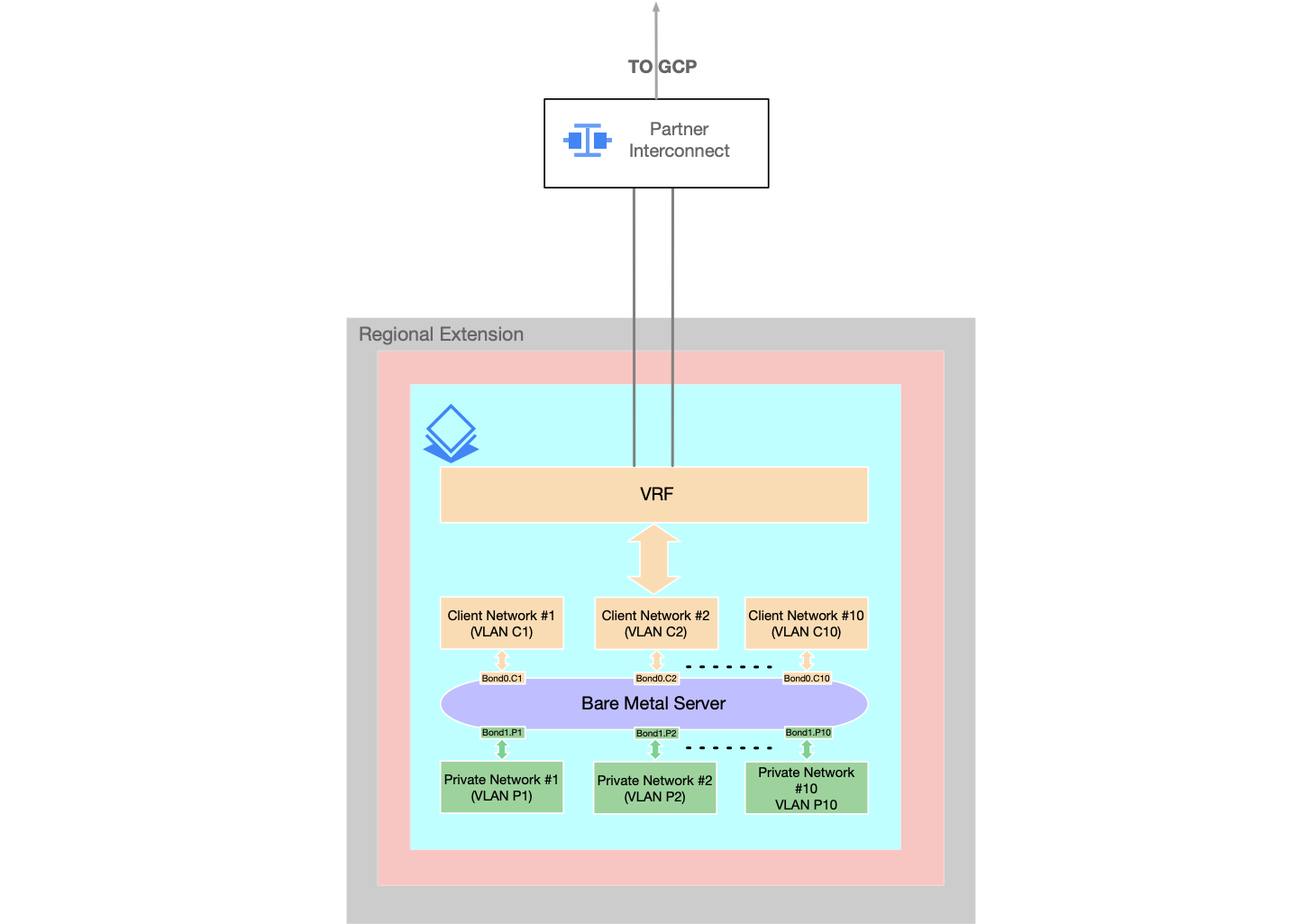
- Before adding multiple networks contact Cloud Customer Care and request a quota for additional networks. If you already have a quota for additional networks, skip this step.
- After you create and attach a network to a server through the Google Cloud console you have the following two options to apply a new network configuration on the server:
- Manual configuration
- This option lets you configure your server manually with new network interfaces, IP addressing and the IP routing.
- Follow creating and attaching a network to a server for instructions.
- Through re-imaging
- The re-imaging will apply a network configuration to a server. No manual configuration needed. For instructions, follow:
- Click the server
- On the Server details page click EDIT
- On Edit Server page select Reimage server
- Specify the OS image.
- Specify SSH keys if you are using Public Key Authentication to access the server.
- Manual configuration
Multiple VLAN attachments
You can configure multiple VLAN attachment pairs over a Partner Interconnect connection to your Bare Metal Solution environment.
- This provides more bandwidth between your VPC and the Bare Metal Solution environment than the bandwidth offered by a single VLAN Attachment pair in a standard networking configuration.
- To configure multiple VLAN attachment pairs, see Create the VLAN attachments for the Partner Interconnect connection in Bare Metal Solution.

Multiple VPC connections
You can connect the Bare Metal Solution environment to more than one Virtual Private Cloud (VPC) in your Google Cloud project.
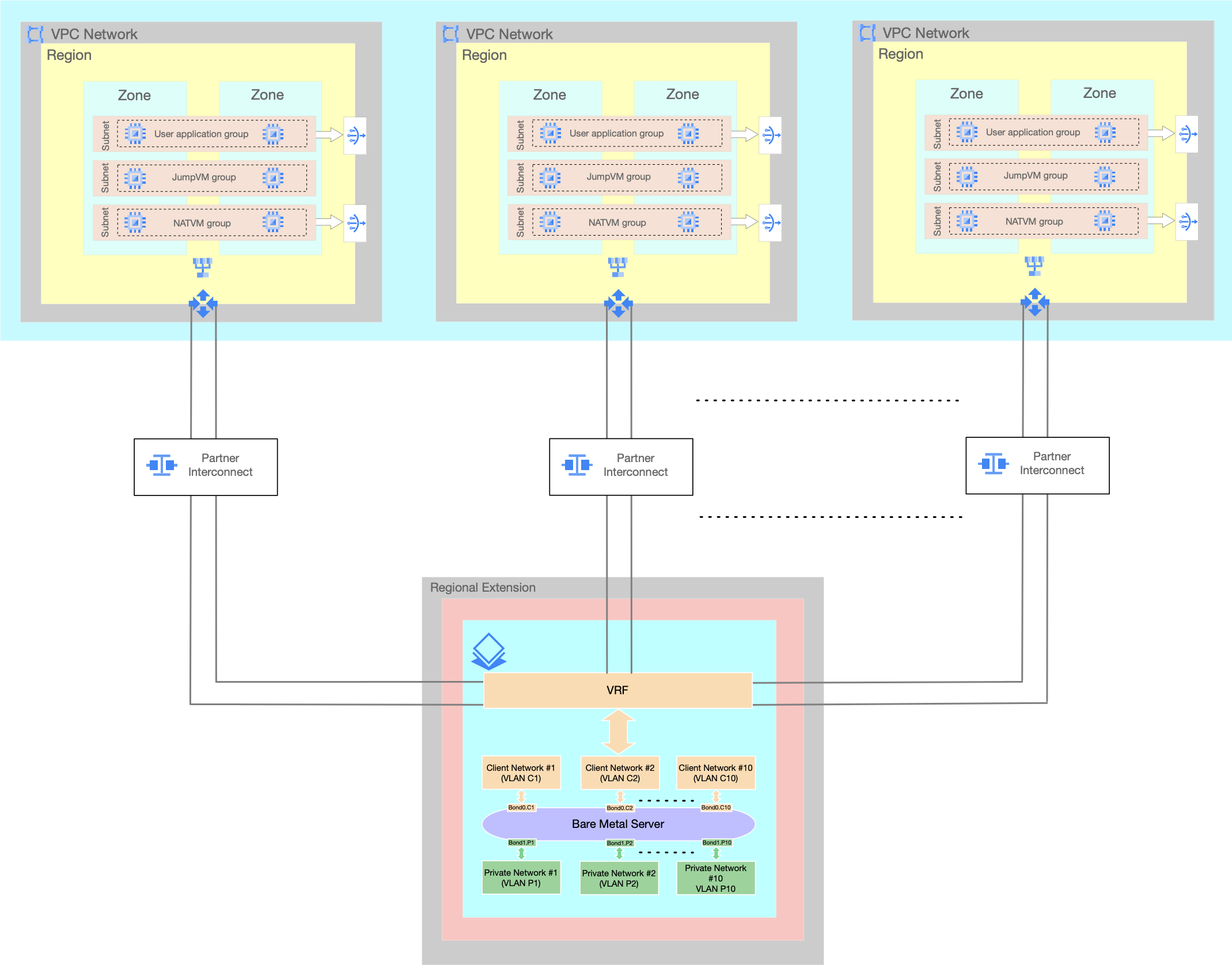
Maximum transmission unit
We recommend you to use the same maximum transmission unit (MTU) for every network to ensure consistent packet switching.
Following is the recommendation for setting up the MTUs for BMS environment:
- Setting up the same standard MTU (1500) for every network segments on the traffic path
- Segments: Client Network, VLAN attachment, VPC network, on-premises network.
- Configure the MTU on your Bare Metal Solution servers by using your
server's operating system.
- For example, to configure MTU on a
Linux server, issue the
ip link set INTERFACE_NAME mtu 1500command on all server interfaces. - To verify the current MTU settings in a Linux server, issue the
ip link show | grep mtucommand.
- For example, to configure MTU on a
Linux server, issue the
Network templates
You can use network templates to enable a flexible network design of your choice, such as active/active and active/backup, to meet your needs for high availability, redundancy, and load balancing.
- Templates allow for different combinations of connections between server interfaces, bonds, and switch ports.
- To learn more about templates and request them for your Bare Metal Solution network, contact Google Cloud Sales.
Connecting Bare Metal Solution to Google Cloud project
We recommend that you create VLAN attachments in redundant pairs so they can be covered by the SLA (Service Level Agreement)). Each VLAN attachment in the pair is provisioned in a different EAD (Edge Availability Domain) for high availability.
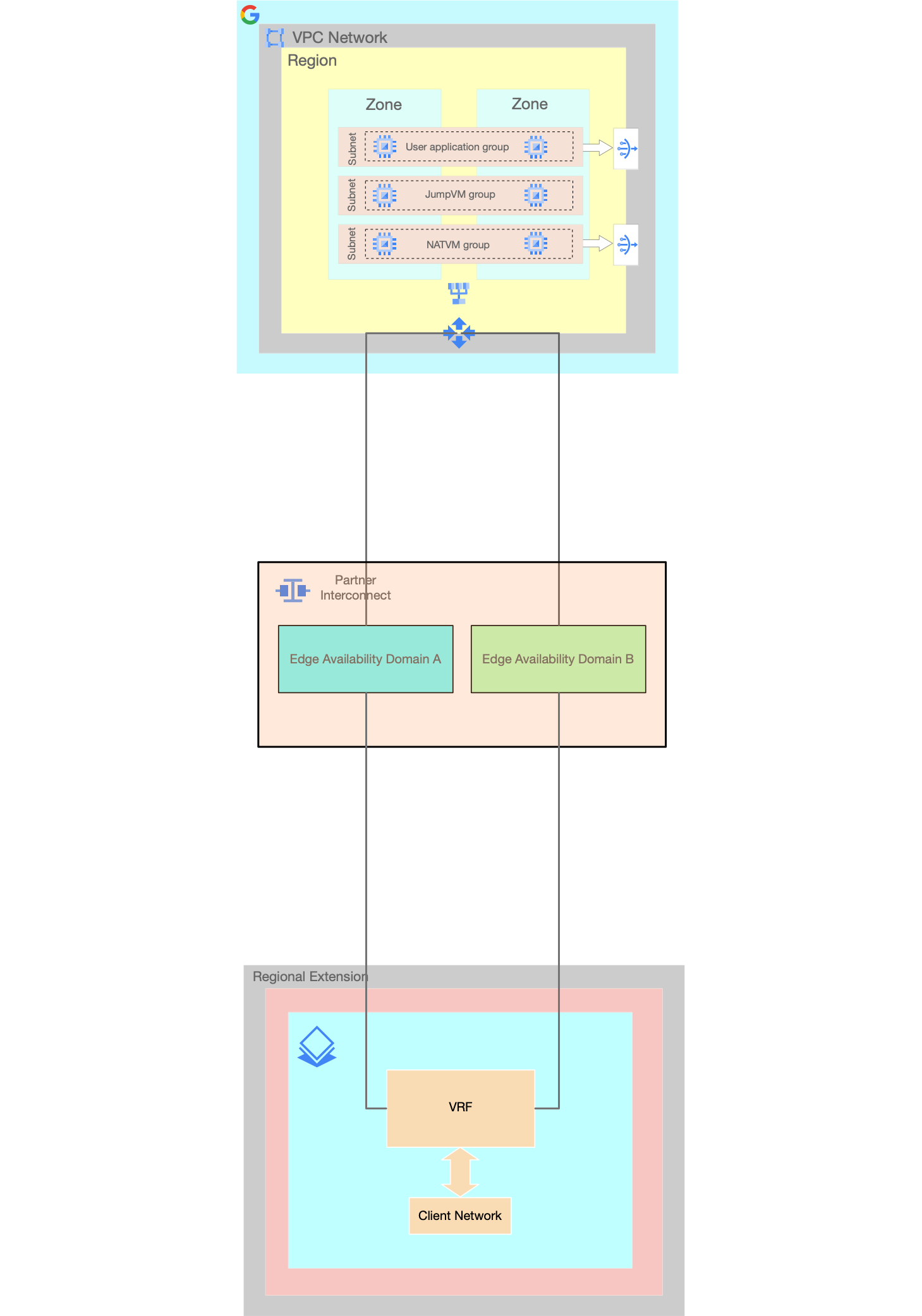
You can use the VLAN attachments in the pair in the following modes depending on how you configure your Cloud Router.
- Active-Standby VLAN attachment mode
- Active-Active VLAN attachment mode
In Active-Standby mode, you can use the primary VLAN attachment for traffic between Bare Metal Solution servers and the Google Cloud project while the secondary VLAN attachment as a standby.
Active-Standby mode can be configured by configuring higher base route priority value on the secondary BGP session and the lower base route priority value on the primary BGP session.
Following example diagram shows the Active-Standby mode with 1 Gbps bandwidth VLAN Attachment.
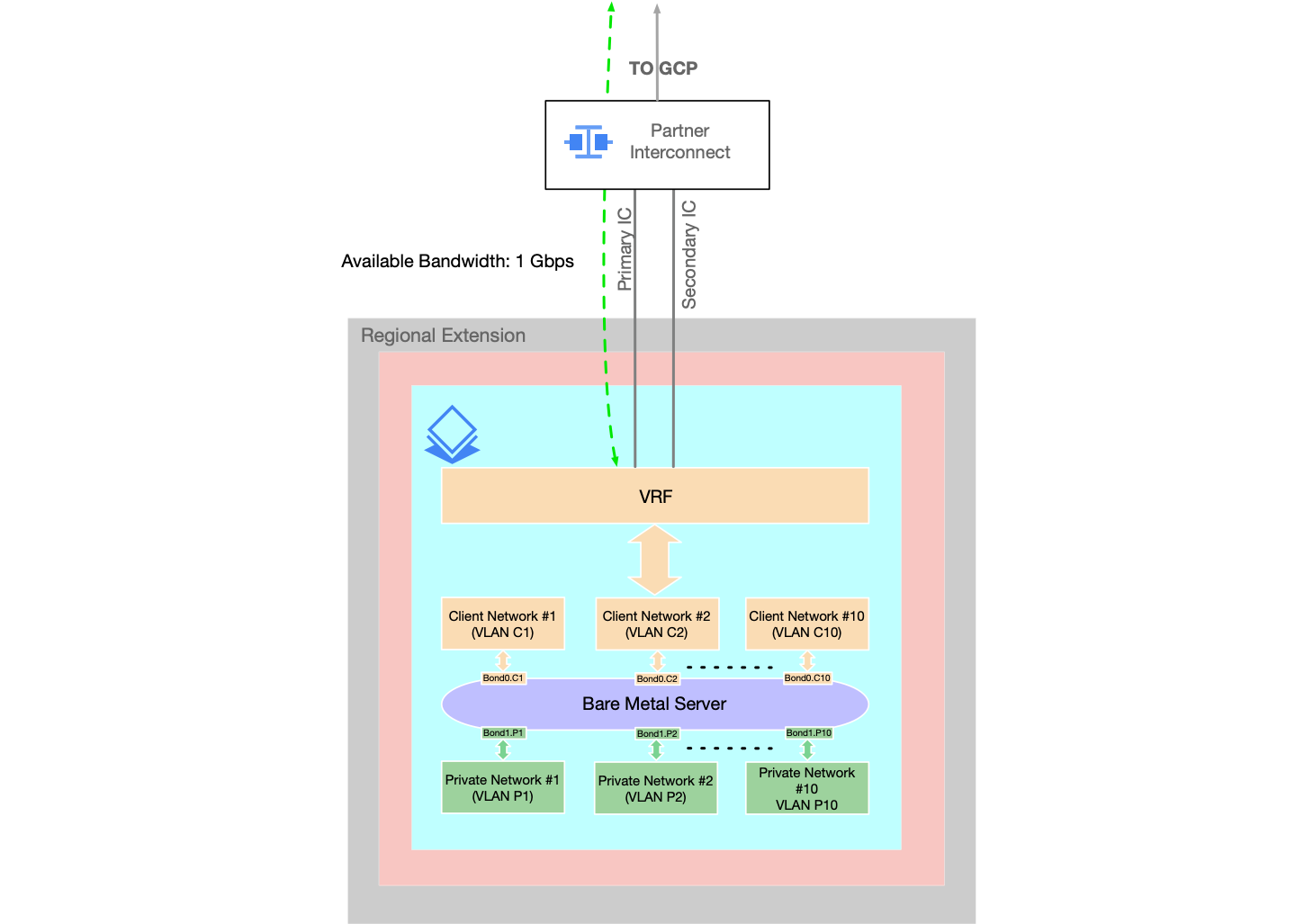
In Active-Active mode, you can configure to load share between both VLAN attachments in the pair for BMS traffic.
By default, the base route priority value on Cloud Router is 100 for all BGP sessions. This means that all VLAN attachment pairs will be used in Active-Active mode without any additional configuration.
Following example shows the Active-Active mode with 1 Gbps bandwidth VLAN Attachment.
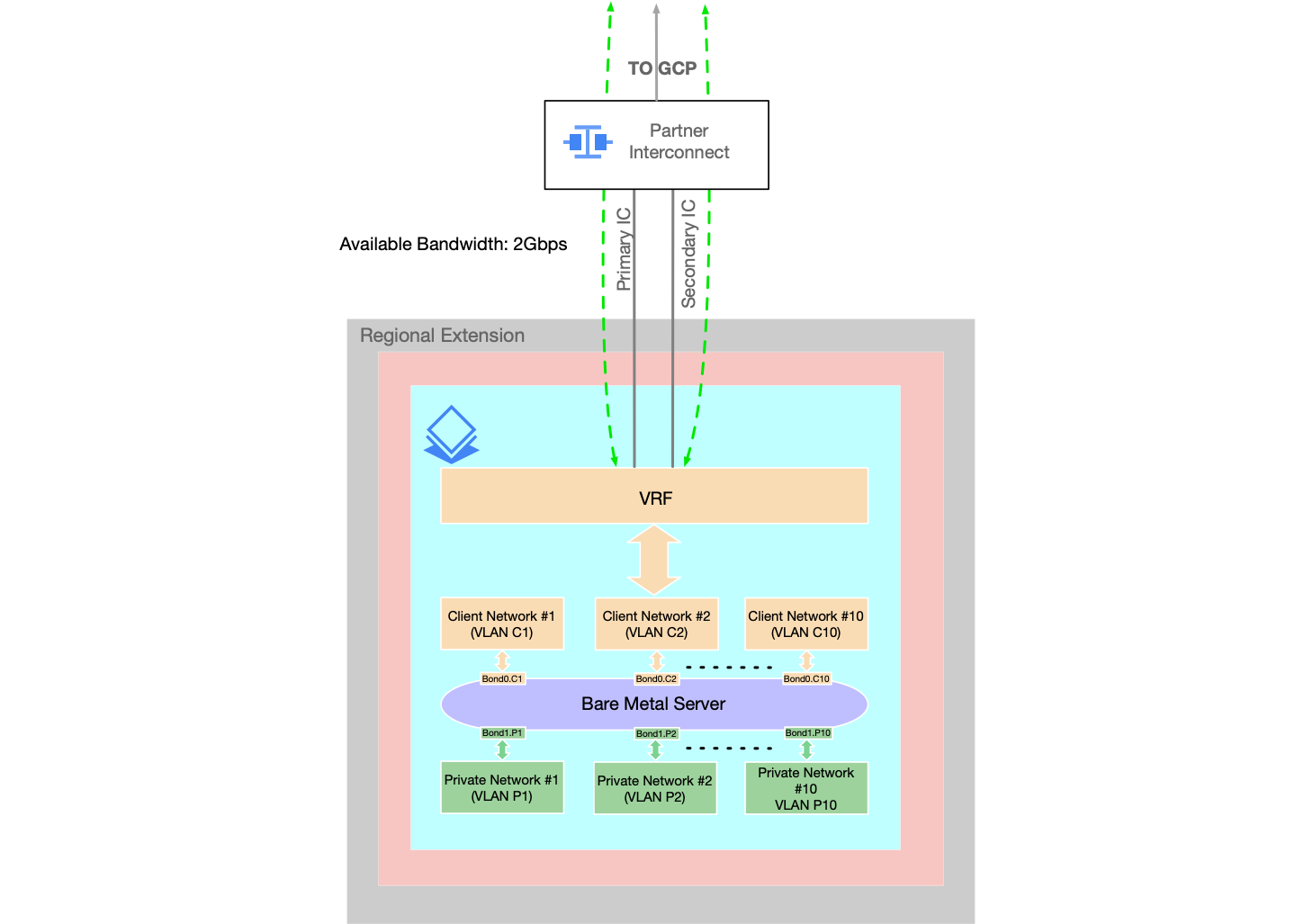
We recommend you not to put a traffic more than the bandwidth of a single VLAN attachment when using in Active-Active mode.
For example: If you create a VLAN attachment with 1 Gbps bandwidth, then the total throughput you can get using Active-Active mode is 2 Gbps (including the redundant pair).
But you need to keep in mind that putting more traffic than 1 Gbps could be risky in this case.
In this example, you put 1.5 Gbps traffic on your VLAN attachment pair and when one of the VLAN attachment goes under maintenance or networking event, you end up with 1 Gbps bandwidth available and 1.5 Gbps traffic which will result a congestion and a packet loss.
Following diagram shows the issue where you put more traffic than single VLAN attachment bandwidth.

Setting up a Google Cloud project for Bare Metal Solution (Internet, secure access)
You can optionally launch the following VMs on their Google Cloud project project for their Bare Metal Solution.
- NATVM
- A Virtual Machine for providing Internet access to Bare Metal Solution servers. See Internet Access solution for Bare Metal Solution for configuring the internet access for Bare Metal Solution servers.
- JumpVM
- A Virtual Machine for providing secure remote access to Bare Metal Solution servers from the public internet
- If you have a Cloud Interconnect (Partner or Dedicated interconnect) or a Cloud VPN connecting your on-premises network directly to Google Cloud project, you can connect from on-premises network to BMS directly without jumpVMs.
- The following diagram shows an example setup of NATVMs and JumpVMs.
- For redundancy, the regional Instance groups have been used with multi-zonal deployment along with internal passthrough load balancers. For more information about regional resources, see Global, regional, and zonal resources.
- If you don't need highly available and scalable NATVMs or JumpVMs then a single instance for jumpVM and NATVM services can be launched and used. This will eliminate the need for Load Balancers.
- NATVMs and JumpVMs are placed in their own subnets.
- The diagram shows three different traffic flows:
- Green flow
- On-premises network -> Cloud Interconnect ( or cloud VPN) -> Partner Interconnect to BMS -> BMS server
- Red flow
- BMS server -> Partner Interconnect -> NATVM -> Internet
- Blue flow
- Remote or Home offices -> Public Internet -> JumpVMs -> BMS server
- Green flow
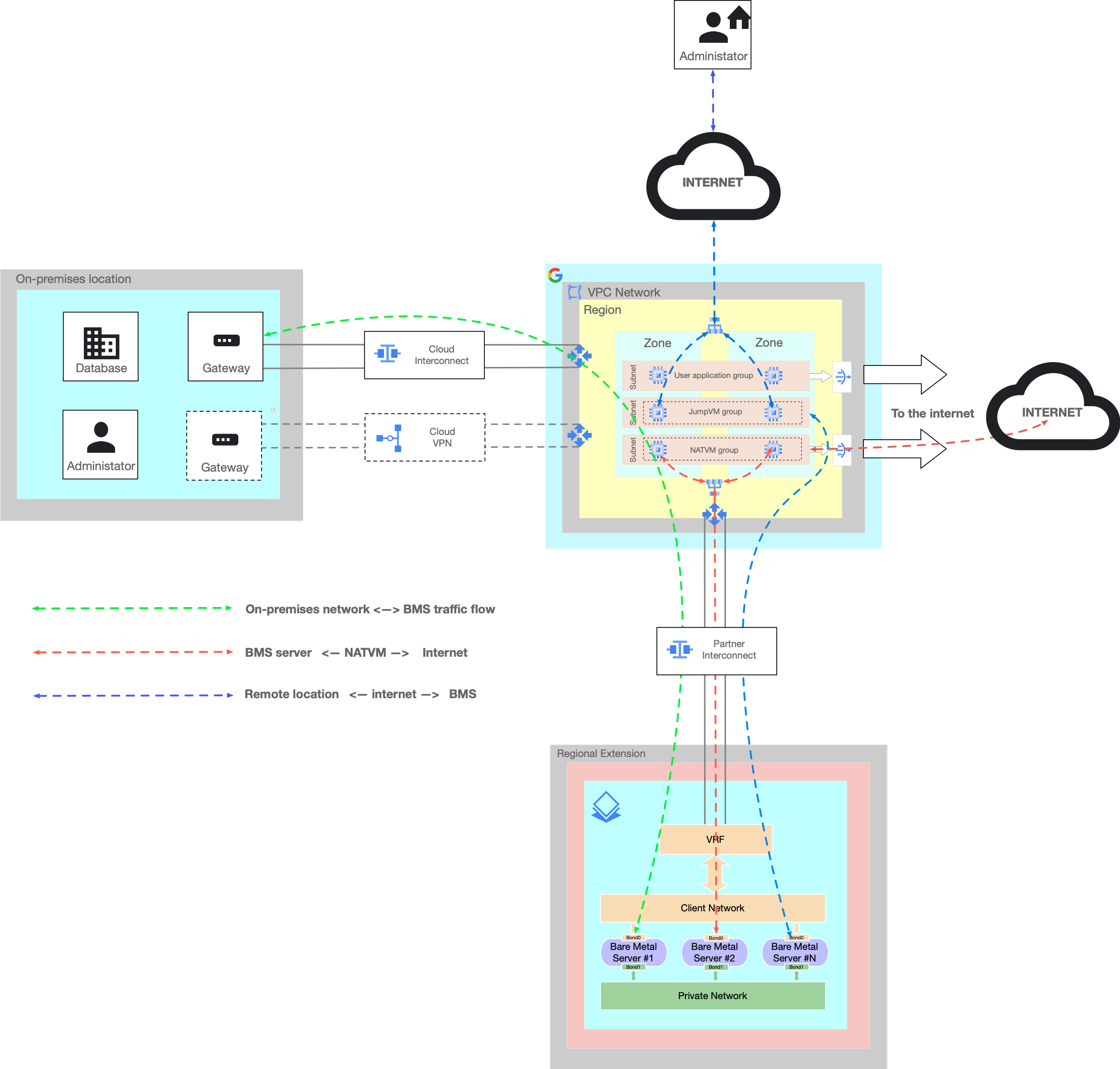
Partner Interconnect for Bare Metal Solution
The connection between your Google Cloud environment and your Bare Metal Solution environment uses the Partner Interconnect framework.
For more information about the Partner Interconnect framework, see the Partner Interconnect documentation, but keep in mind the following differences applicable in the context of Bare Metal Solution:
- This connection to the Bare Metal Solution environment is not subject to the pricing model that the Partner Interconnect product uses. For more information about the pricing model, talk to your Google Cloud Sales representative.
Define your own IP address spaces
You can use your own IP subnets in the Bare Metal Solution environment. This lets you to fit your Bare Metal Solution into any existing IP address schema that your enterprise might have.
When you place an order for Bare Metal Solution, you provide two internal IP address ranges: a client IP address range for communication between your Google Cloud and Bare Metal Solution environments, and a private IP address range used for accessing services and devices within the Bare Metal Solution environment.
You can also select the specific IP addresses to use with each server. Consider the following guidelines:
- Make sure that no existing IP addresses in your VPC network or your extended on-premises network conflict with the IP ranges that you use for Bare Metal Solution environment.
For every subnetwork that you request for Bare Metal Solution, Google Cloud reserves five IP addresses from the subnet range for administration purposes. These include the network address, the broadcast address, and the last three usable addresses in the range. For example, if you request the 100.64.0.0/27 subnet range, we reserve the following addresses:
- 100.64.0.0: Network address
- 100.64.0.28, 100.64.0.29, and 100.64.0.30: Last three usable addresses in the range.
- 100.64.0.31: Broadcast address
Request subnet ranges with at least a /27 subnet, so that you can assign the /28 subnet for Bare Metal Solution services. Subnets using /29 to /32 do not contain enough usable addresses for either Bare Metal Solution services or your Bare Metal Solution servers.
In an auto mode VPC network, 10.128.0.0/9 CIDR block is reserved. See Auto mode IPv4 ranges. If you want to connect to an auto mode VPC network, use IP ranges outside of 10.128.0.0/9 for your Bare Metal Solution environment.
Bare Metal Solution does not support Class E IP addresses (240.0.0.0 to 255.255.255.254).
Multi-region networking considerations
For any outside communication, including communication with services or your on-premises environments, the communication from your Bare Metal Solution environment must pass through the VPC network that you are using to connect to your Bare Metal Solution environment.
Consider using a single VPC network with global_dynamic routing enabled if your Bare Metal Solution environment will require access to other Google Cloud regions to connect to any of the following resources:
- Other Bare Metal Solution environments
- VMs in other regions
- Other Google Cloud services
- Your on-premises sites in other geographical locations
Using a VPC network with global dynamic routing and custom advertisement mode, you can set up a routed environment to connect your Bare Metal Solution instances directly to your Google Cloud and extended on-premises environments in other regions, without any additional configuration in Google Cloud.
Our recommendation is to advertise a default route on the BGP sessions to Bare Metal Solution. This enables you to:
- Avoid having to make change to routes to the Bare Metal Solution environment even if things change in your VPC subnets or your on-premises environments.
- Keep the routing table to Bare Metal Solution small and allow it to contain only one prefix.
Network services and your Bare Metal Solution environment
As described earlier, Google Cloud recommends that you advertise a single default route to your Bare Metal Solution environment to keep the routing table simple. However, if your circumstances don't allow that, the routes that you need to expose to your Bare Metal Solution environment are determined by networks and services in your Google Cloud or on-premises environments that need access to the devices or applications in your Bare Metal Solution environment and vice-versa.
Some services that might require routes include NTP servers, DNS servers, LDAP servers, logging services, monitoring services, and so forth, as well as any other workloads and applications that need to communicate with the Bare Metal Solution environment.
Bare Metal Solution does not come with internet access. If you need to, you can setup routing to access the internet through any existing internet gateways that you have, either on Google Cloud or on premises.
Keeping routing simple
Outside of the other servers in the same Bare Metal Solution region, your servers likely need to communicate with one or more of the following:
- Your endpoints in your Google Cloud environment
- Your extended on-premises environment through your Google Cloud environment
- Your servers in Bare Metal Solution environments in other regions through your Google Cloud environment
- The internet through your Google Cloud environment
Firewalls and the Bare Metal Solution environment
When planning your firewall implementation for the Bare Metal Solution environment, there are a couple things to consider.
If you need to control traffic between the servers or applications within the Bare Metal Solution environment (east-west traffic), ask your Google Cloud sales representative for the available options.
In your VPC network on Google Cloud, you need to create firewall rules that allow incoming connections from the Bare Metal Solution environment.
Required networking information for your Bare Metal Solution order
When you submit a Bare Metal Solution order, include the following networking information:
- The Google Cloud project ID that you are using with your Bare Metal Solution environment.
- The IP ranges that you intend to use in your Bare Metal Solution environment. For example, the client IP address range used for communication between your Google Cloud and Bare Metal Solution environments, and the private IP address range used for services and devices within the Bare Metal Solution environment.
- The number of VLANs you need in your Bare Metal Solution environment. Keep in mind that you need at least 2 VLANs for each Partner Interconnect.
- The bandwidth, in
1 Gbpsincrements, that you need between your Google Cloud environment and your Bare Metal Solution environment.
Backup, restore, and disaster recovery
To protect against potential disruptions, we recommend that you plan and implement your solutions for backup, restore, high availability, and disaster recovery. For more information, see Plan for disaster recovery.

